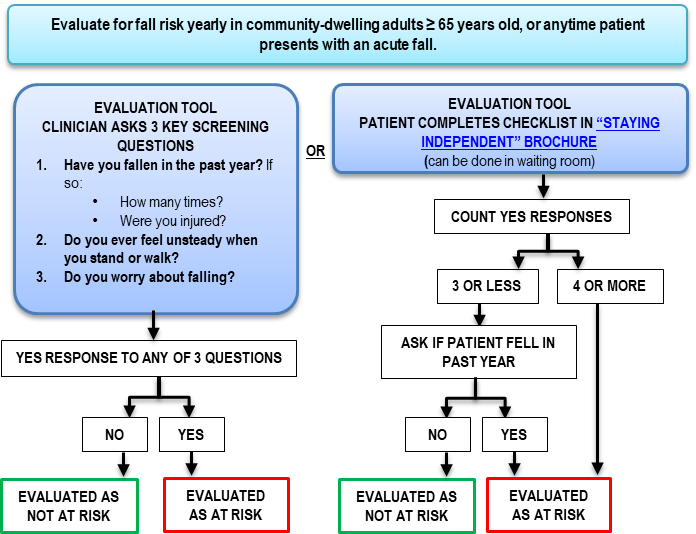About Dementia Fall Risk
About Dementia Fall Risk
Blog Article
Dementia Fall Risk Can Be Fun For Anyone
Table of ContentsDementia Fall Risk Fundamentals ExplainedUnknown Facts About Dementia Fall RiskExcitement About Dementia Fall RiskUnknown Facts About Dementia Fall RiskThe 9-Minute Rule for Dementia Fall Risk
The FRAT has 3 sections: fall risk standing, risk element list, and action strategy. A Fall Threat Status consists of data about history of current falls, drugs, mental and cognitive standing of the client - Dementia Fall Risk.If the patient scores on a threat variable, the equivalent number of points are counted to the person's fall risk rating in the box to the far. If a client's loss danger score totals five or greater, the individual goes to high danger for falls. If the client scores only 4 factors or reduced, they are still at some danger of dropping, and the registered nurse ought to utilize their finest scientific evaluation to manage all fall risk elements as component of an alternative treatment strategy.
These typical methods, generally, aid establish a risk-free atmosphere that lowers accidental drops and defines core safety nets for all individuals. Indicators are essential for patients in jeopardy for falls. Health care providers require to acknowledge that has the condition, for they are accountable for carrying out activities to advertise person safety and security and protect against falls.
Dementia Fall Risk - The Facts
Wristbands should include the patient's last and first name, date of birth, and NHS number in the UK. Only red color should be used to signify special patient standing.
Products that are too far may require the person to get to out or ambulate needlessly and can possibly be a risk or add to falls. Assists protect against the individual from heading out of bed with no support. Registered nurses react to fallers' phone call lights quicker than they do to lights started by non-fallers.
Visual impairment can substantially trigger falls. Keeping the beds closer to the floor lowers the risk of drops and significant injury. Positioning the bed mattress on the flooring dramatically decreases autumn threat in some health care settings.
Some Ideas on Dementia Fall Risk You Should Know
Clients who are high and with weak leg muscles who attempt to sit on the bed from a standing placement are most likely to drop onto the bed because Check Out Your URL it's too low for them to lower themselves securely. Also, if a high person efforts to rise from a low bed without help, the person is likely to drop back down onto the bed or miss out on the bed and fall onto the floor.
They're made to promote prompt rescue, not to prevent drops from bed. Aside from bed alarm systems, increased supervision for risky patients also might assist protect against falls.
.png)
Patients with a shuffling gait rise loss possibilities significantly. To minimize autumn threat, footwear must be with a little to no heel, slim soles with slip-resistant tread, and support the ankle joints.
Dementia Fall Risk Things To Know Before You Get This
In a study, homes with adequate lighting record less falls (Ramulu et al., 2021). Enhancement in lighting at over at this website home might decrease loss rates in older adults.

Sitters work for ensuring a secure, safeguarded, and Read Full Report safe atmosphere. Research studies demonstrated very low-certainty evidence that caretakers lower fall threat in severe care health centers and just moderate-certainty that choices like video clip tracking can reduce sitter use without raising fall risk, recommending that caretakers are not as beneficial as initially thought (Greely et al., 2020).
The smart Trick of Dementia Fall Risk That Nobody is Talking About
.png)
Enhanced physical fitness decreases the danger for falls and limits injury that is sustained when autumn transpires. Land and water-based exercise programs may be in a similar way valuable on balance and stride and thereby reduce the threat for drops. Water workout may add a positive benefit on balance and stride for women 65 years and older.
Chair Surge Exercise is a straightforward sit-to-stand exercise that helps reinforce the muscular tissues in the thighs and butts and enhances movement and freedom. The goal is to do Chair Increase exercises without using hands as the customer becomes stronger. See resources section for a thorough instruction on just how to execute Chair Rise exercise.
Report this page